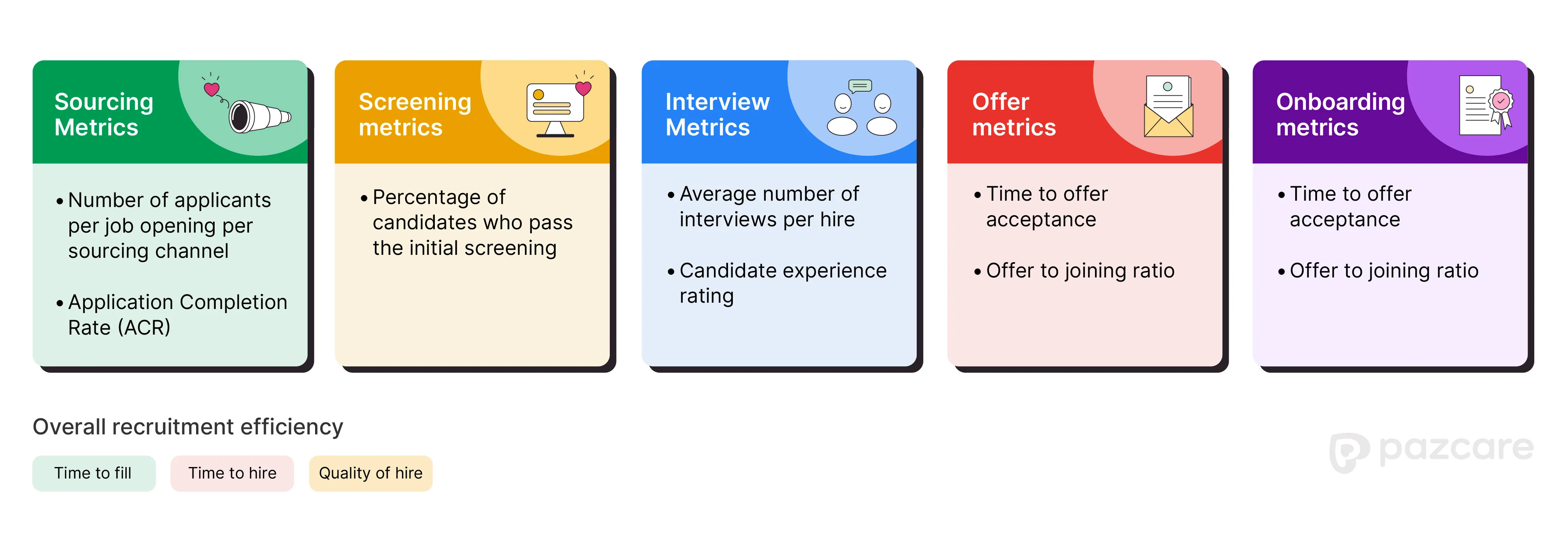What are recruitment metrics?
Recruitment metrics are some easy calculations that will give you a sense of understanding and direction regarding your company's recruitment process. Quantifying a few aspects of hiring processes will help you plan better in terms of budget, effort and time spent.
In this blog, we will focus on the most common and important recruiting metrics.

Sourcing Metrics:
Number of applicants per job opening per sourcing channel
This is the number of people who apply to your job listings. You can also segregate it based on the sourcing channel. Sourcing channels means from which channel you are getting applicants or the channels you use to get applicants. It could be sites like Wellfound, Indeed, Naukri LinkedIn or referrals from employees or agencies. Applicants for different roles are in different channels. This metric will give you visibility on it.
This helps you analyse what is the average number of applicants you are getting for similar roles. This also helps you double down on the best sourcing channels.
Application Completion Rate (ACR)
Here you will be tracking how many people complete the full application process you have set up. As this is the first touchpoint where an applicant interacts with your job listing, it is important for you to ensure a smooth experience.
A lesser completion rate can indicate problems like
- Browser incompatibility
- Lengthy process
- Unnecessary questions
- Many open-ended questions
Screening Metrics:
Time to screen applicants
This recruitment metric that measures the amount of time it takes for a hiring team to review and evaluate a candidate's application materials after they have been submitted. This metric typically begins once the job posting has closed and the hiring team begins reviewing applications.
A shorter time to screen applicants indicates that the hiring team is able to quickly assess candidates and move them through the recruitment process more efficiently. You can invest in Applicant Tracking Software (ATS) that can process resumes in bulk.
Percentage of candidates who pass the initial screening
Here you measure the number of candidates who successfully make it through the initial screening phase of the hiring process. This metric typically refers to the number of candidates who meet the minimum qualifications for the role and are therefore deemed eligible for further consideration.
The formula is
(Number of candidates who passed the initial screening / Total number of candidates who applied) x 100
Interview Metrics:
Average number of interviews per hire
The average number of interviews per hire is a recruitment metric that measures the number of interviews it takes to make a single job offer. The number of interviews will differ depending on the position or department. So it is advised to calculate this based on it.
The formula for calculating the average number of interviews per hire is:
Average number of interviews per hire = Total number of interviews conducted / Total number of job offers made
For example, if an organization conducted 50 interviews and made 10 job offers, the average number of interviews per hire would be 5 (50 interviews / 10 job offers).
For highly sought-after roles, it may take more interviews to find the right candidate, while for less competitive roles, fewer interviews may be needed. You can find what is the industry standard and tweak yours.
Candidate experience rating
Candidate experience rating is a measure of the satisfaction level of job candidates with the overall recruitment process of an organization. It reflects how well the organization has treated candidates during the recruitment process, from the initial application stage to the final hiring decision.
The candidate experience rating can be measured through various methods, including candidate feedback surveys and online reviews. Candidates may be asked to rate various aspects of the recruitment process, such as the job application process, the communication from the hiring team, the interview experience, and the overall impression of the company's employer brand.
A positive candidate experience can lead to a higher acceptance rate for job offers, a better reputation as an employer, and increased referrals from candidates
Offer Metrics:
Offer to joining ratio
This metric identifies how many people join your organization as against the number of job offers you rolled out. This helps you understand three main things
- How competitive your compensation and benefits are
- Your strategy strength to decrease offer shopping.
- Bad reputation (Applicants ask around before joining)
To calculate,
No. of candidates accepted and joined / Total number of offers rolled out x 100
Onboarding Metrics:
Time to productivity
The time to productivity metric in HR is a measure of the amount of time it takes for a new employee to reach full productivity in their role. This metric is important for organizations to track as it can help them understand the effectiveness of their onboarding process, the quality of their training programs, and the overall performance of their recruitment efforts.
The formula for calculating time to productivity is:
Time to Productivity = (Date the employee is fully productive) - (Date the employee started)
To determine when an employee is fully productive, the organization must establish clear performance metrics and goals for the position. These metrics and goals can be used to track the employee's progress and determine when they have reached a level of performance that meets the organization's standards for productivity.
It's important to note that the time to productivity metric can vary widely depending on the role and the complexity of the job. For example, a new employee in a highly technical or specialized role may take longer to reach full productivity than a new employee in a more general role.
One year attrition rate
This determines how many employees leave within one year of being hired. It co There are two types; voluntary (Resignation, death, retirement) and involuntary ( layoffs, behavioural issues). A higher attrition rate means you have to look into your organizational culture, structure, growth and leadership. Higher attritions cause a lack of continuity and training gaps which ultimately affect growth and team dynamics. Conduct surveys among employees to understand what is wrong and work towards solutions to reducing voluntary attrition.
Overall recruitment efficiency
Time to fill
Time-to-fill is the number of days between when a job requisition is approved and when the offer is accepted by the applicant. In simple terms, it is the time taken to fill a position. This metric is an indicator of how long it takes for your company to close vacant positions.
Time to hire
Time to hire measures how much it takes from a candidate’s first touch point to being hired. The first touchpoint is generally applying with a form on a website/job site. Time to fill includes the time before a candidate interacts with your listing. Whereas time to hire, focuses only after candidates engage.
Having a shorter time to hire is crucial to keep the recruitment process engaging and quick to not miss out on best candidates who have applied.
Quality of hire
This metric helps you understand what value your hires are bringing in. If you don't see much value, you can work on improving the quality by rising your expectations. The scale to measure quality differs with companies. The key is to have parameters that are suitable for your organisation. For example, culture fit, leadership quality, attitude, performance, etc. can be some of the parameters.
Cost per hire
This is the expense you incur for every employee you recruit. This includes money put into advertisements, time spent by HRs and hiring manager, consultancy/agency cost, etc.
To cut down your advertisement costs, work on your employer branding on social media, website careers page and review websites like Glassdoor.
To calculate,
Divide total expenses incurred for open roles and divide it by the number of hires made with that expense.
Cost per hire = Total recruitment cost/ total number of hires





.svg)
.svg)
